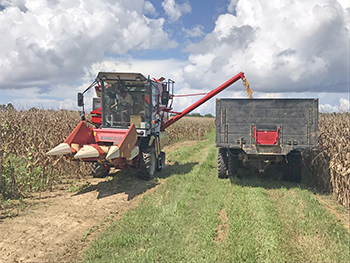New Plot Combine Helps Farmers Harvest Information

An investment from the Alabama Wheat & Feed Grain Producers checkoff helped purchase a new plot combine for researchers that is paying dividends with its first corn harvest.
The group’s $150,000 contribution toward the $320,000 combine helped purchase the machine for the Alabama Agricultural Experiment Station in Fairhope. The combine finished gathering the station’s corn crop in September before harvesting soybeans a few weeks later, said Station Director Malcomb Pegues.
“This new combine is already helping us out a lot,” said Pegues, who emphasized that data gathered at research stations serves as unbiased information for farmers. “In years past, we’ve shared a combine with the experiment station in Brewton. Transporting a combine from Brewton to Fairhope takes time, and sometimes traffic is an issue. Also, invariably we’d have the combine here, and it would rain for two or three days when it hadn’t rained at all in Brewton. Being able to harvest at the optimum time is an important part of any research. Having our own combine has already had a positive impact.”
And size matters, Pegues noted.
Research plots are usually 20-to 30-feet long and four rows wide -— too small for a full-size combine, which typically harvests at least eight rows at once. The new Kincaid plot combine has a two-row corn head and a reduced-size grain table for harvesting wheat and small grains in test plots.
Station Associate Director Jarrod Jones said in addition to updated software monitoring equipment, the plot combine cleans grain better and records more data, which provides more information farmers can use in making decisions for their farms. And because the Baldwin County area typically records 67 inches of annual rainfall, he said having a four-wheel drive combine helps ensure a timely harvest.
“It can take a long time for this soggy soil to dry out when we have a lot of rain,” Jones said. “I’ve gotten the plot combine we formerly used stuck trying to get in the field when it was too wet. The four-wheel drive feature came in handy this year with all the rain we’ve had.”
Cherokee County’s Nick McMichen said research done at the Fairhope station and the state’s 13 other experiment stations is important to Alabama agriculture.
“Checkoff dollars and investments in research at the experiment stations are crucial to farmers’ success,” said McMichen, vice chairman of the Alabama Wheat & Feed Grain Producers. “Farmers can count on information gained from that research to be impartial, genuine and factual.”
The checkoff is a self-imposed fee wheat and feed grain farmers pay for research, education and promotion. A producer panel of farmers from throughout the state determines how the money is spent.
Click here for more information.
